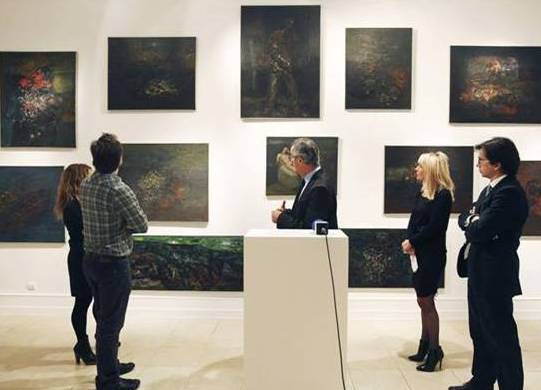Exhibition “White Holes, Black Holes”. The Museo de Arte Moderno y Contemporáneo de Santander (MAS) covers the artistic career of Enrique Gran, in an exhibition that includes more than a dozen unpublished paintings from the sixties. (27/12/2013)
An exhibition shows unpublished works by Enrique Gran
Published by: Canal Patrimonio On: December 26, 2013

The Museo de Arte Moderno y Contemporáneo de Santander (MAS) covers the artistic career of Enrique Gran, through the works he keeps in his collection, in an exhibition that includes more than a dozen unpublished paintings from the sixties.
Heritage Channel
White Holes, Black Holes is the title of this review of Gran’s artistic career, which includes works dated between 1952 and 1981, representative of all his stages, except for the last one, known as the white stage, of which there are no samples in the MAS collection. The exhibition can be visited until 16 February and is limited to the MAS’ own collection of 23 paintings, more than half of which had not been exhibited before.
For the director of the Santander museum and one of the curators of the exhibition, Salvador Carretero, this is one of the few artists who dared to experiment with the avant-garde in an era when the official painters were in the majority.
The exhibition includes paintings from the first stage of Gran (Santander 1928-Madrid 1999), when in the post-war period he broke with the prevailing officialism and from which MAS conserves figurative canvases such as Río de la Pila and neo-cubist works such as Bodegón cubista, from 1954. Later he began to experiment with a sordid figurative informalism in works in which Carretero sees the influence of Pancho Cossío, who sponsors his first exhibition at the Círculo de Bellas Artes in Madrid, in 1959.
The Goya Trail
The exhibition allows us to trace the impact that Goya’s black paintings, which he visited the Prado Museum so often, had on Gran’s work, and the fascination for energy and light that he always felt, to the point that one of his great hobbies was to gut electrical appliances, said the director of the MAS. He also illustrates his passage from figuration to abstract painting, with completely informalist compositions, in the sixties, after his participation in the Venice Biennale.
According to Begoña Merino, Enrique Gran’s niece and president of the Foundation that bears her name, Antonio López once said that the artist from Santander moved from the figurative to the abstract like Picasso, but better. Gran and López appeared together in Víctor Erice’s film El sol del membrillo, which documents the creative process of the painter from La Mancha and also the friendship that unites them both.
IMAGE: A group of people observe several of the works of the painter Enrique Gran (Santander 1928 Madrid 1999), in the exhibition organised by the Museo de Arte Moderno y Contemporáneo de Santander (MAS). EFE
